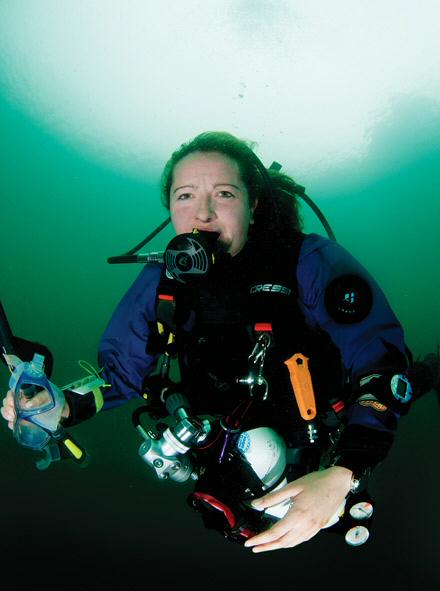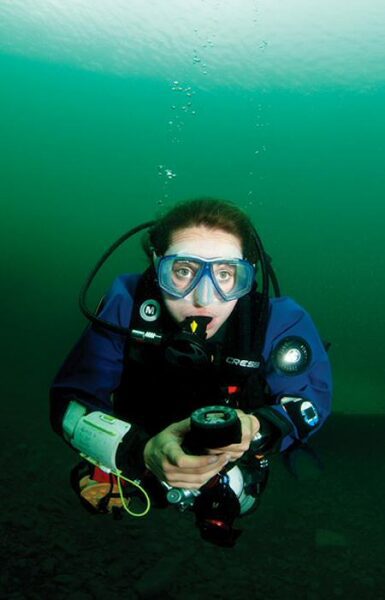
How our man NIGEL WADE became the UK’s first to qualify as a PADI Self-Reliant Diver – is the agency’s new course truly a ‘milestone moment’
IN THE PAST, the mere mention of solo-diving would spark debate as to whether the practice was safe, ethical, or even enjoyable to undertake.
Arguments have raged between exponents of solo-diving and champions of the buddy system. DIVER’s John Liddiard once labelled the practice as “the last diving taboo”.
Update: Nigel Wade passes away
Yet every day tens of thousands of divers “go it alone” around the world, many of them without the training or qualifications to do so.
It could be argued that most don’t even know they’re doing it.
Take the instructors teaching divers on their initial open-water dives – could their students help if a problem arose? Or the divers who buddy-dive regularly, but find that they have drifted apart in poor visibility.
How about divers who perform a perfect descent, only to find that they have to wait at depth for the rest of their buddy team to catch up because of equalisation problems.
In theory, these scenarios shouldn’t happen. Divers should stay together and be available to assist their buddies if a problem occurs.
In reality on virtually every dive, at some point, divers unwittingly find themselves on their own, if only for a short time.
Underwater photographers actively seek to dive alone. They see it as possibly the only way to return with striking images. If Peter Scoones had been forced to dive with a buddy, or in groups, would he have won a BAFTA and two Emmys? Would we have marvelled at all the awe-inspiring footage generated by the BBC Natural History Unit over the years? Probably not.
Many underwater images have been captured by divers far from the crowds, diving as independently as possible to avoid disturbing their quarry, and with no other divers or bubble-streams appearing in the background.
I’M NO PETER SCOONES, but as a photographer I do attempt to dive solo regularly in the vain hope that I will one day get the “big shot”.
I completed a Scuba Diving International (SDI) Solo Diving course in 2005, gaining the skills and knowledge needed so that on production of my C-card I would at least be allowed to stray from the group.
Alas, with well in excess of 3000 dives and qualifications up to my armpits, I have encountered dive centres that would not recognise my solo credentials. They insisted that I dive with the group and follow the divemaster along with my appointed buddy.
That buddy, incidentally, would quite probably be newly certified, with fewer than a dozen dives, and prove to be a real handful, surfacing after only 20 minutes on 10 bar while I still had 150. To add insult to injury, I would be paying for the privilege.
The same outfit would, of course, turn a blind eye as the dive-guide dropped through the water column on his own to tie in the anchor-line.
For as long as I can remember, PADI has championed the buddy system. Its whole ethos has been about diving for fun and sharing the experience safely with like-minded divers.
It has rightly defended the system passionately as the cornerstone of its diver training, leaving individuals who wish to dive alone to do so elsewhere.
In 2001, however, a senior PADI official acknowledged for the first time that solo diving could be carried out in safety by suitably experienced divers.
The comments were made by Drew Richardson, PADI Worldwide Senior Vice-President, in response to a US diving magazine article.
It had claimed that buddy-diving could be dangerous, and that sport divers should give themselves the independence of a solo diving set-up.
Richardson replied that PADI’s buddy system was an effective and safe approach for the average recreational diver, and that the demands of solo-diving were a step too far in the skills required. To advocate it as an alternative to buddy-diving was, he said, “irresponsible and reckless”. For the suitably qualified and experienced diver, however, the principles of solo-diving could be accepted.
In 2009, New Zealand-based PADI and TDI instructor Andy Connor of Tech Dive NZ considered the need for divers to be more independent.
Using his technical diving background and experience, he devised a course based on training divers to be “self-sufficient” should they encounter a problem under water.
The Self Sufficient Diver course was, surprisingly, approved by PADI. Connor, in conjunction with Global Dive and Tech Dive NZ, supplied and delivered the course and certification as an alternative to SDI’s solo course.
In May 2010, Egypt’s Chamber of Diving & Watersports (CDWS) issued a statement on solo-diving. To be allowed to dive solo, it said, a diver had to successfully pass a solo-diving training course and earn such a certification from a recognised training agency.
Procedures, rules, recommendations and standards of the training agency would apply for the diving activity.
The technical manager and/or at least one of the instructors of the licensed operation must be certified as a solo-diving instructor. They were then perfectly capable and responsible for making the right professional decisions – to allow divers to dive solo.
IN LATE MAY, I contacted PADI International’s Director of Training Suzanne Pleydell, to establish the agency’s current position on solo-diving.
“PADI supports the proven system of diving with a partner for several reasons, not least its contributions to diver safety,” she stated. “The goals of training divers include developing the skills to take responsibility for themselves and to be self-reliant.

“The buddy system provides a safety redundancy to this skill base that diving alone simply cannot provide.
“PADI also recognises that experienced divers, after being specifically trained in self-reliant diver techniques, such as dive-planning, redundant and specialised equipment configurations, problem management etc, can be prepared to dive independent of a partner and to accept the added risks involved.
“Responsible self-reliant diving is diving alone with the correct mental discipline, attitude and equipment. When divers select this specialised activity within this description, PADI sees a place for it.”
Suzanne went on to explain that only two days earlier, PADI itself had released a speciality programme entitled Self-Reliant Diver, enabling qualified divers to dive independently of others.
I immediately tried to locate a UK-based instructor offering the course, but it was so new that my quest proved problematic. Then Simon Lodge of Crystal Palace-based Lodge Scuba came to my rescue.
Simon provides training through various agencies, specialising in technical and cave-diving.
He is currently involved in exploration diving in Mexico’s Yucatan cenotes. As a cave-diver, he regularly dives without a buddy.
I booked a course, along with my underwater model and PADI Staff Instructor Sarah Morgan, to see what it was all about.
Prerequisites
To undertake the course, you need to have a minimum 100 logged buddy dives and be at least a PADI Advanced Open Water Diver or equivalent from another training agency.
The standard PADI Self-Reliant Diver liability release and assumption of risk form needs to be read and signed.
The course was completed in a day, including theory sessions and three open-water dives, at the National Dive Centre at Stoney Cove in Leicestershire.
Course introduction
“This course is an introduction to self-reliant diving that helps student divers develop the skills, knowledge and techniques necessary to rely on themselves first,” Simon explained.
There were two main reasons to undertake the training, he said: firstly, “to develop the skills needed to plan and carry out dives without a partner, whether through preference or necessity” and, secondly, “to sharpen the skills of the self-reliant diver, creating a stronger partner in a dive-pair or team”.
We discussed the philosophy of, and motivation for, diving without a partner, analysing the potential risks involved and possible ways to manage them.

Simon identified the value of kit redundancy and back-up equipment we would require, not just for the course but on all our self-reliant dives.
The kit
An independent air source is compulsory, although there is no standard set-up.

A 3-litre pony cylinder mounted on the main cylinder is the simplest solution, but you could opt
for a side-mounted stage cylinder, or even a complete side-mount system – or perhaps a twin-set configured independently, all complete with first stage, regulator and submersible pressure gauge.
It’s down to the individual’s needs and preferences.
A spare mask; spare bottom-timer and depth gauge (dive computer); dive knife (where permitted locally); DSMB and reel, with enough line for the maximum planned depth; and a surface-audible signalling device are all mandatory items of equipment.
Simon had bought along enough kit to enable any configuration we might need. After discussing the options and the pros and cons, we chose our set-ups.
Sarah opted for a side-mounted 7-litre stage cylinder that could be attached while at the surface. I chose a 3-litre pony, because it wouldn’t interfere with my camera set-up.
Planning & managing
Simon explained how to formulate a dive plan for a dive without a partner; how to calculate our surface air-consumption rates (SACs), which can be used to establish how much we use at various depths; and how to determine an appropriate reserve for safe bail-outs.
We discussed how to manage various emergency scenarios, which included dealing with free-flowing regulators, mask issues, currents, entanglement, exceeding planned depth or time limits, panic, stress, out-of-gas situations, cramps, over-exertion and environmental hazards.

Dive 1
After putting our kit together, we were ready to get wet. We entered the water and conducted buoyancy checks.
After a few adjustments to our weighting, we set off for a relaxed 200m surface swim.
Once completed, Simon asked us to descend and hover for a minute at around the 4m mark.
Then it was down to the training platform to perform a simulated regulator free-flow, breathing from our alternative air source for two minutes.
We then performed SAC rate swims, by swimming for five minutes at 10m; the information was recorded on our slates.
Finally, we deployed our DSMBs from depth, and ended the dive after completing our safety stops.
Dive 2

During the second dive we were required to demonstrate time, depth and gas-supply awareness by recording our depth and cylinder pressures at 10-minute intervals throughout the entire dive.
The first task was to conduct a “no-mask swim” covering a minimum distance of 18m.
We then had to simulate an out-of-air emergency, deploying our redundant gas supply while continuously swimming.
Navigation skills were next on the list. Simon sent us off to find the Viscount cockpit and return to our starting point using compasses.
This was followed by navigating our way to the Nautilus submarine and back using natural references.
After another five-minute SAC rate swim and deployment of our DSMBs, we terminated the dive.
We calculated our SAC rates during the surface interval, for use on dive 3.

Dive 3
The last dive saw us enter the water, having first calculated and agreed on a turnaround pressure based on our SAC rates and rule-of-thirds gas management.
We had to demonstrate depth, time and gas-supply awareness by writing the depth and time on our slates for each 20 bar of gas consumed.
We also demonstrated turnaround pressure and time-limit awareness, when either the pressure or time limit established during the briefing was reached, by writing the time or pressure (whichever came first) on the slate.
On the dive we again performed an emergency OOA drill, swapping to our redundant supplies as we swam.
We ended the dive by deploying our DSMBs, and ascended to 5m to conduct our last safety stop of the day. It was time for a well-earned cup of tea.
Written test

We completed the knowledge reviews, which included more SAC calculations. Sarah whizzed through them, leaving me to struggle with a mind that refused to work anymore. It had been a long day.
I eventually finished. Simon quickly marked the reviews, and then it was high fives and loud whoops all round (well, it was a PADI course, after all!).
I reckon PADI has got it spot on.
This is not a solo-diver course in the true sense, nor was it intended to be. The word “solo” is not used in the course materials – it’s all about self-reliance.
The course provides the diver with the skills, knowledge and mental attitude to undertake dives in a much safer way than ever before within the PADI diving system. Being self-sufficient makes sense, with the emphasis on anticipating, preparing for and dealing with problems if and when they occur.
All divers would benefit from this course, whether they want to dive on their own or not.
PADI is still the champion of buddy-diving, as it always will be. However, the fact that it now acknowledges that “a suitably qualified and equipped diver with the right mental attitude, if they are prepared to accept the risks involved, can dive independently of another diver” is likely to change “The Way the World Dives” forever.
Underwater photographers will applaud PADI’s new programme. It will be recognised by PADI centres worldwide as opening new doors and creating opportunities for image-making among recreational divers.
I actually want to dive with other divers. I enjoy their company, and a second pair of eyes is always welcome.
I also enjoy the security.
But place a camera in my hands, or a seabed of scallops in front of me, and all at once I’m a “lonesome dove”, actively seeking to be alone to enjoy my art.
I’m not advocating solo-diving, and it’s not for everyone, but the self-reliant diver with the right gear and skills will always be safer under water, even more so as part of a team.
The buddy system isn’t on the verge of extinction. Thanks to the PADI Self Reliant Diver Speciality, it’s just become a whole lot safer.
THUMBS-UP FROM UNDERWATER PHOTOGRAPHERS
“I think this is a milestone moment. PADI has confronted what may be recreational scuba’s most divisive issue. PADI is by far the world’s largest recreational scuba training agency. Recognition from PADI means that solo-diving has, overnight, become a legitimate activity.
“At a time when personal freedom to dive has become increasingly restricted for recreational divers, this is a bold move. It’s a bit like repealing Prohibition. Where PADI leads – as it has done on many occasions – the industry follows.
“I think this is the most significant change to recreational diving since PADI introduced the modular scuba course and popularised the sport.
“PADI deserves great credit. Speaking as one who makes a living from providing services to underwater photographers, we will immediately start booking trips for our clients with those operators who embrace the Self-Reliant Diver programme.”
Underwater photography equipment retailer & instructor Steve Warren
“Very often, when photographers are absorbed by their subject, they are essentially solo-divers, even if their buddy is in the vicinity.
“If the industry gives divers the knowledge, tools and standards to be able to rely solely on themselves, this development will be an important step forward, and one we would encourage.”
British Society of Underwater Photographers (BSoUP) Chairman JP Trenque
- The PADI Self Reliant Diver distinct speciality course is offered for £150 by Simon Lodge, 0208 765 1036 or 07736 064 625.
- PADI International (UK)
- National Diving Centre

